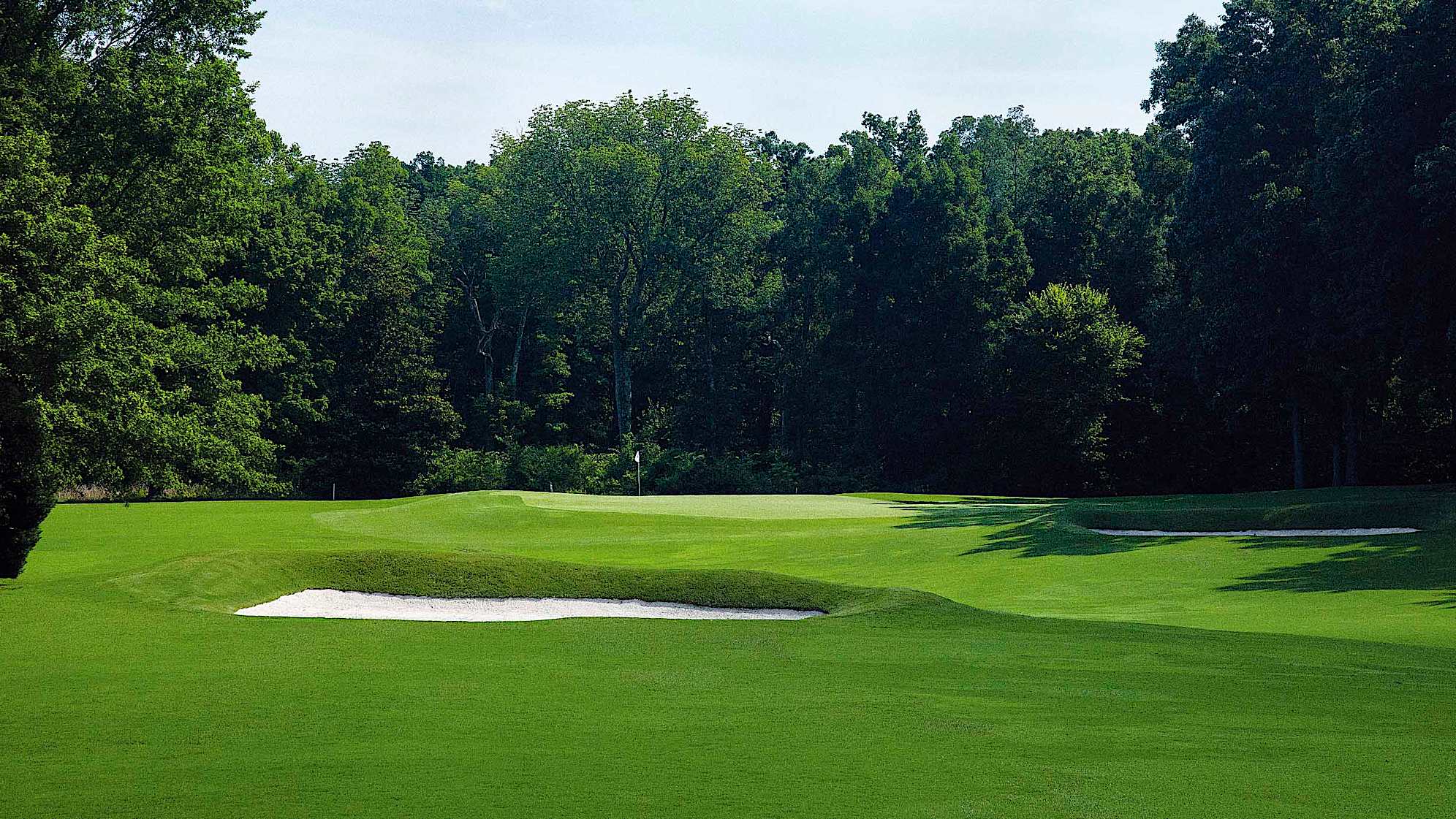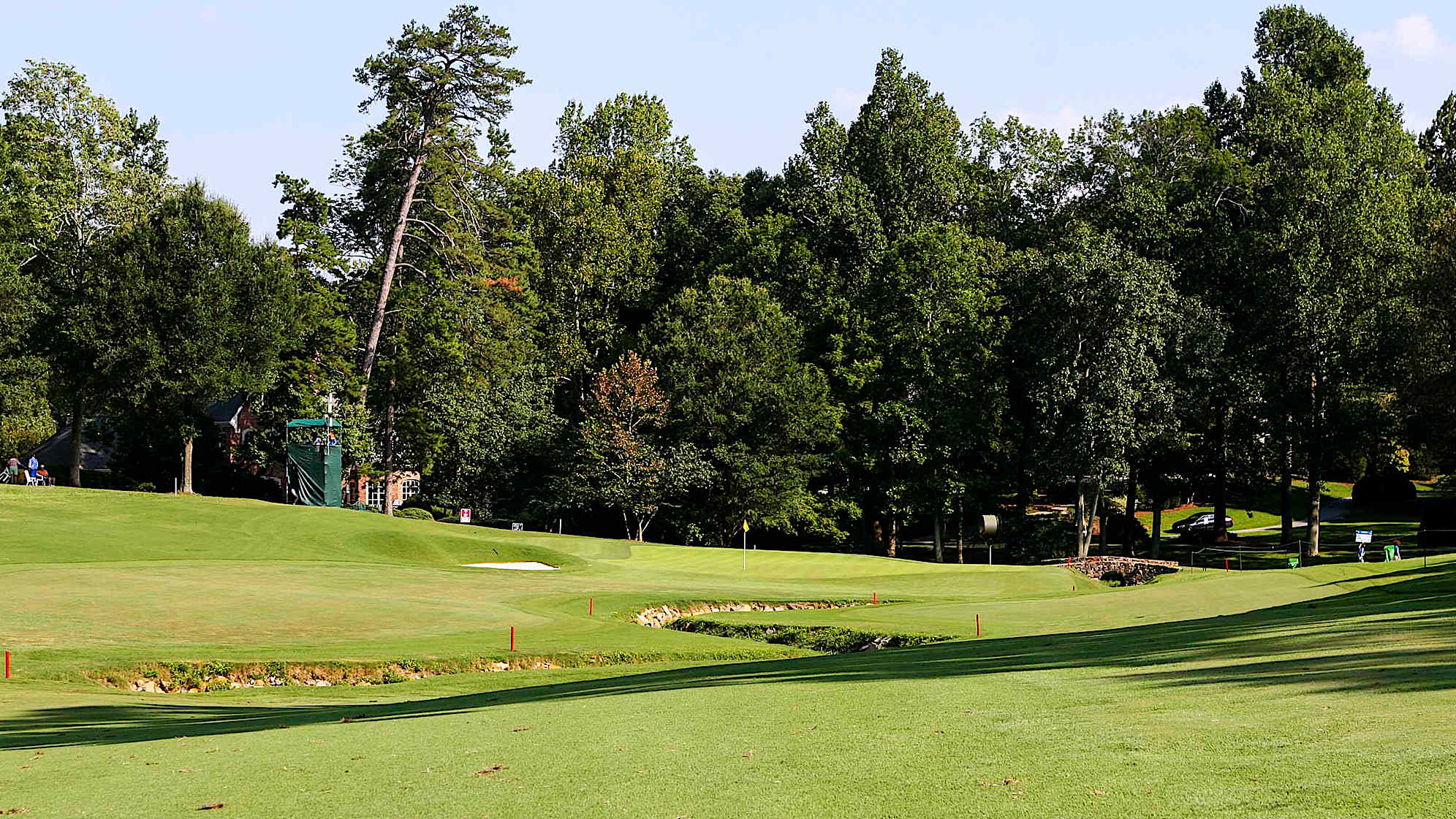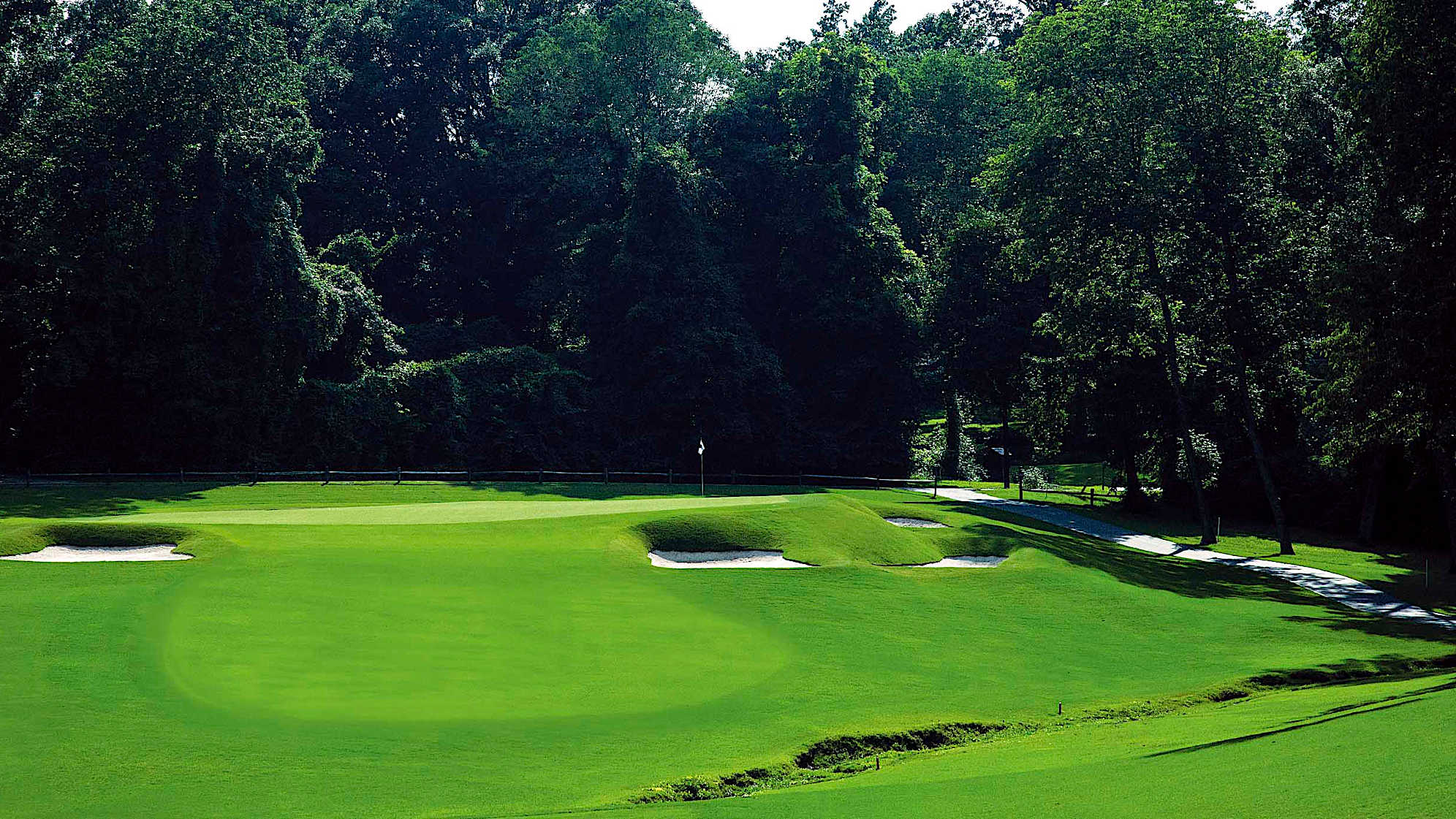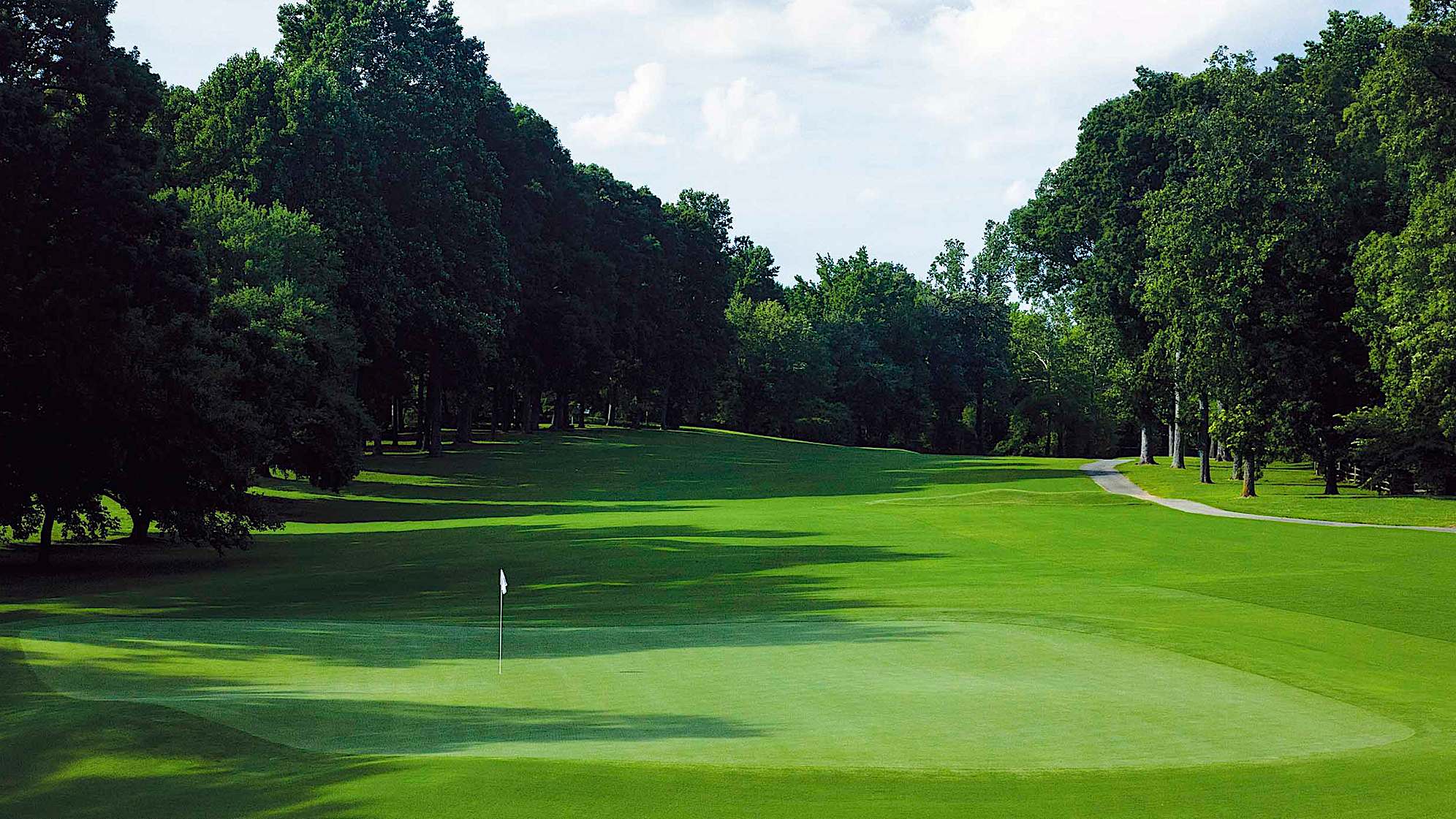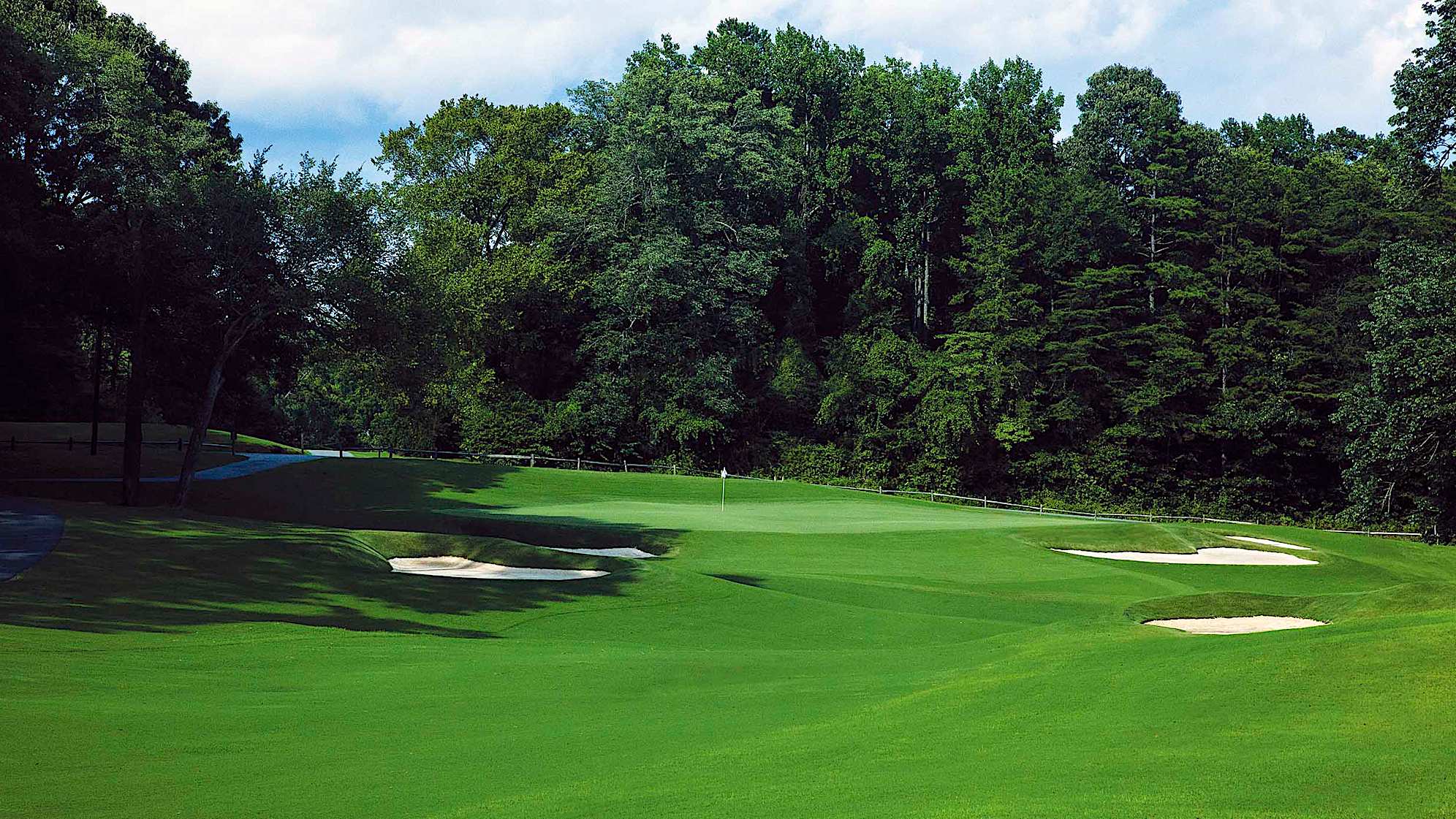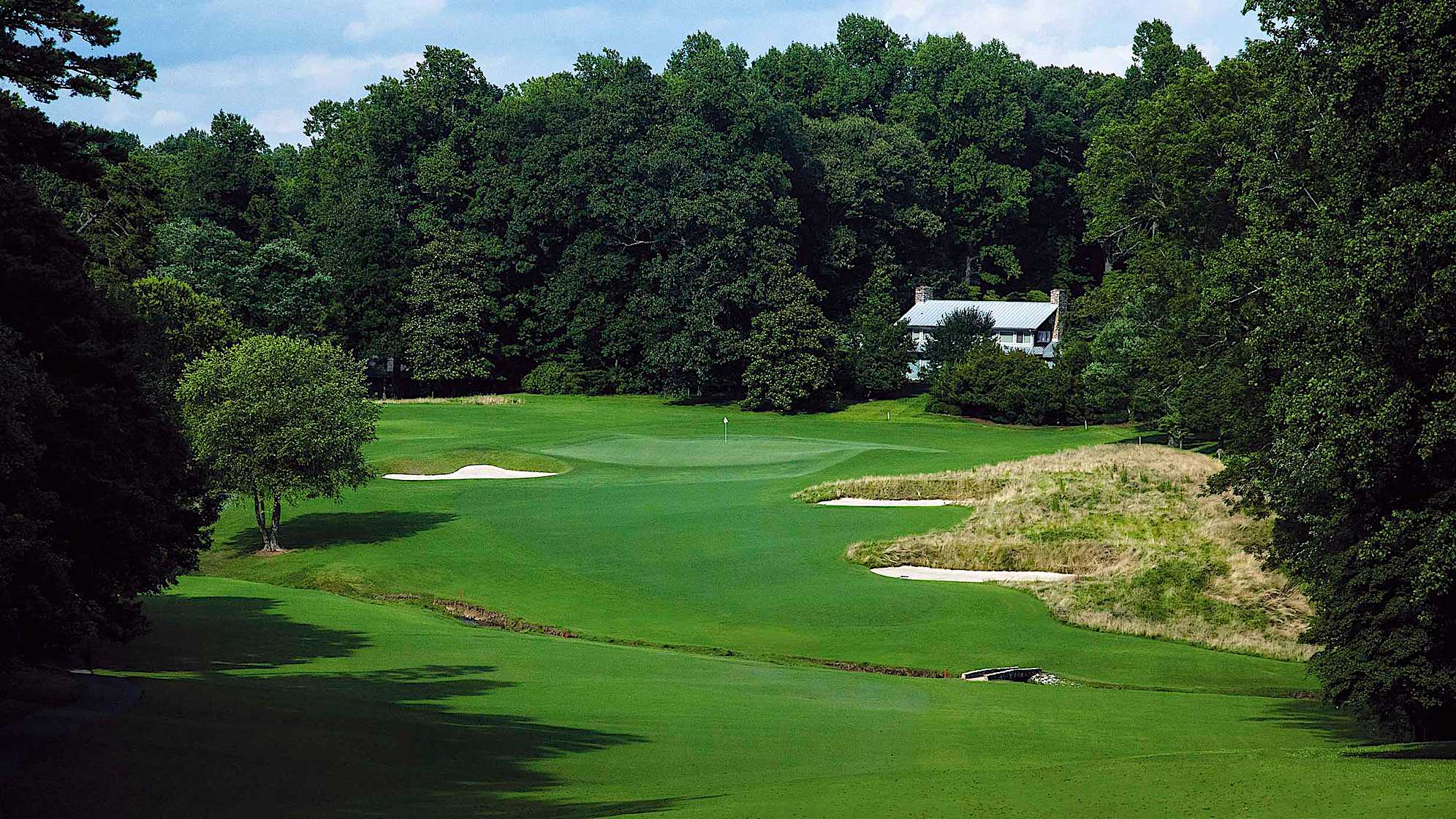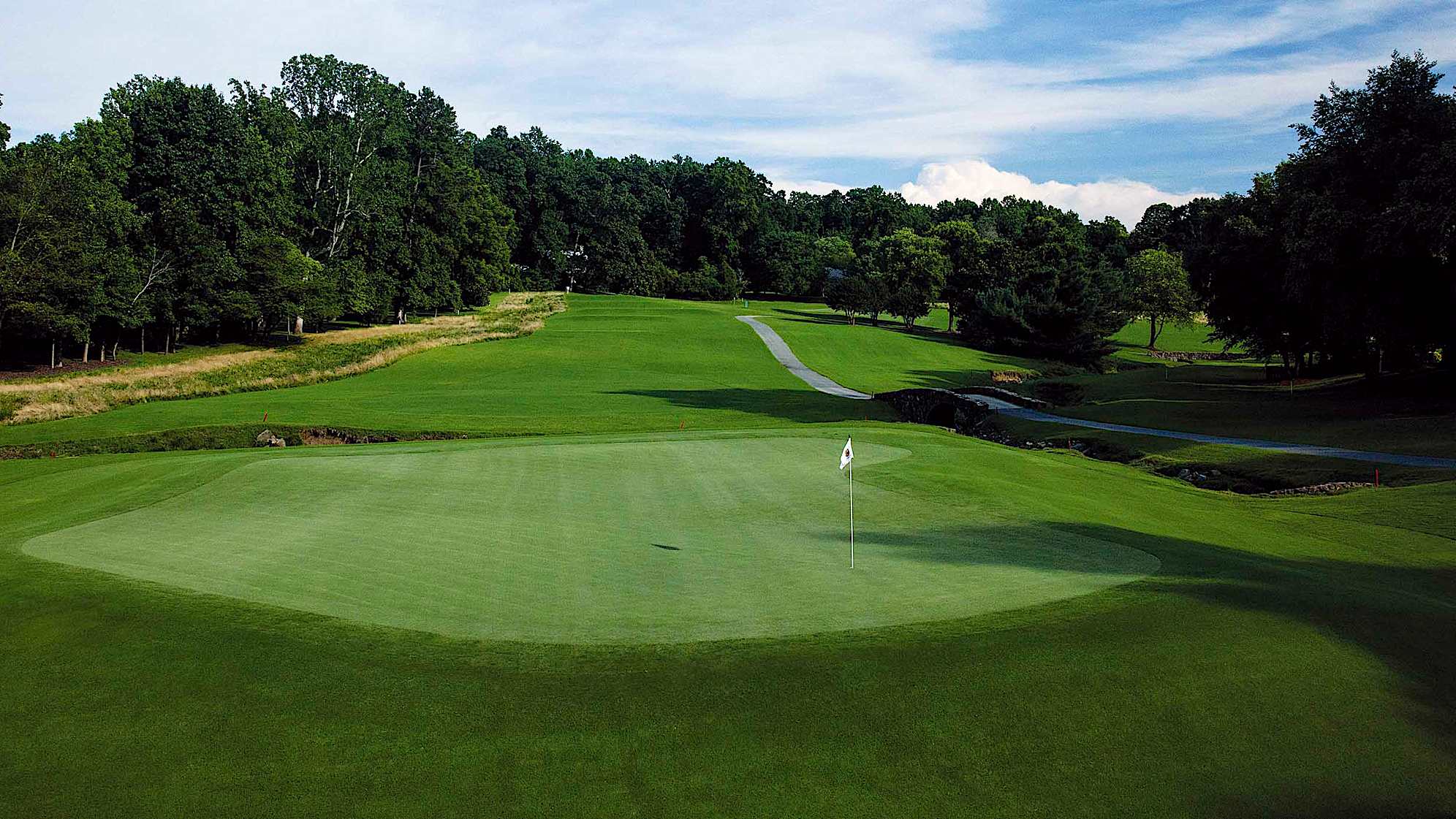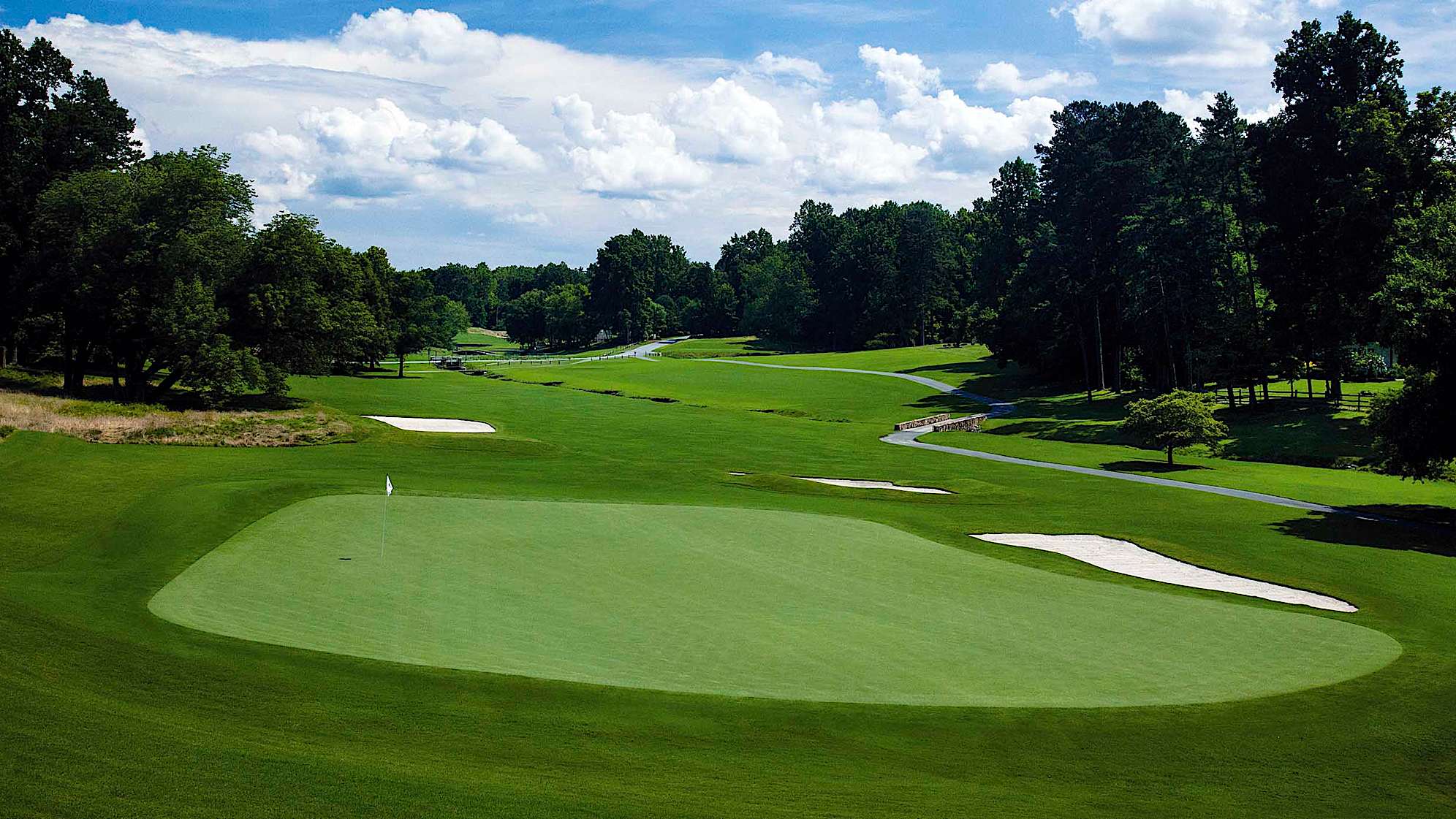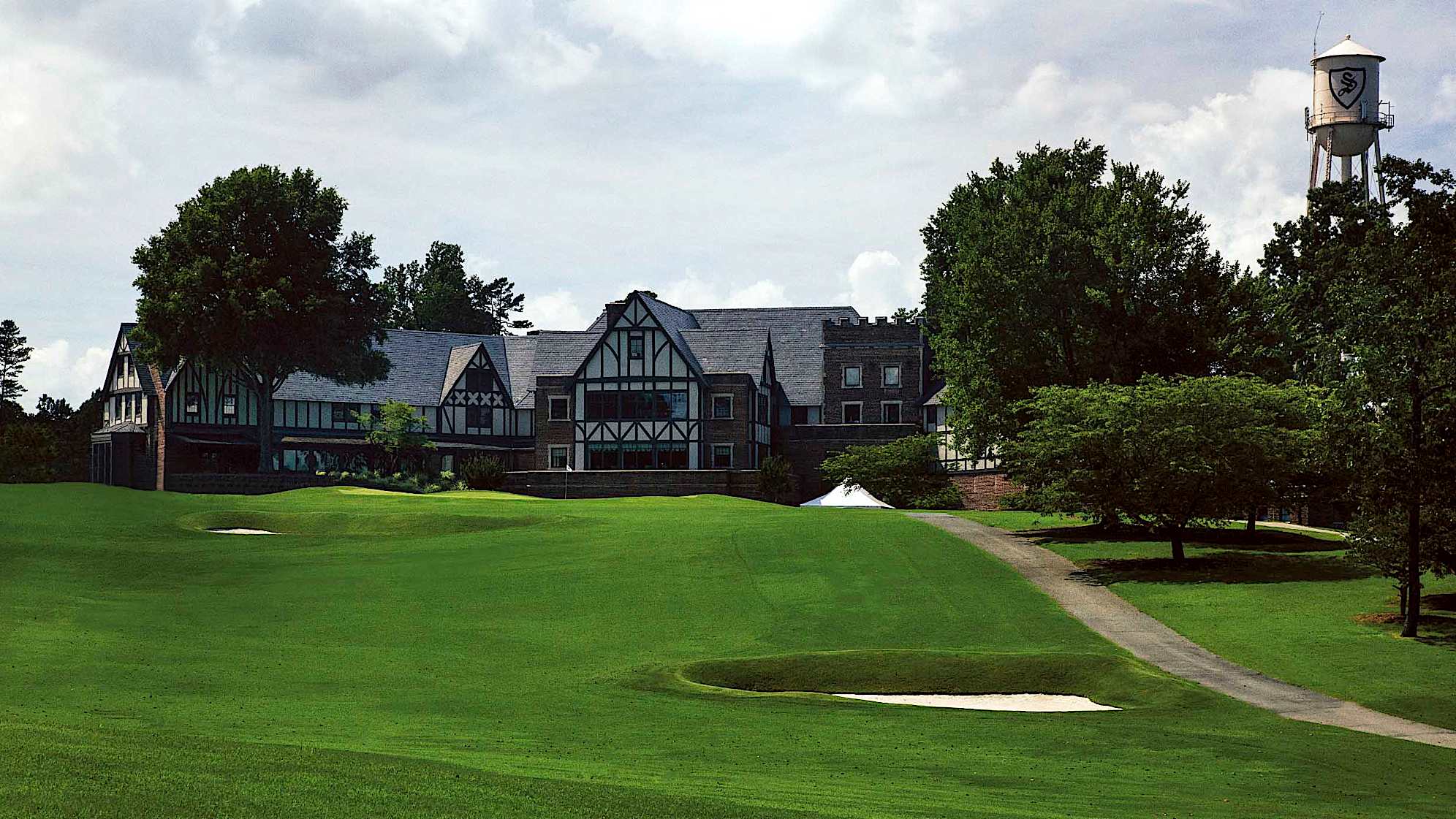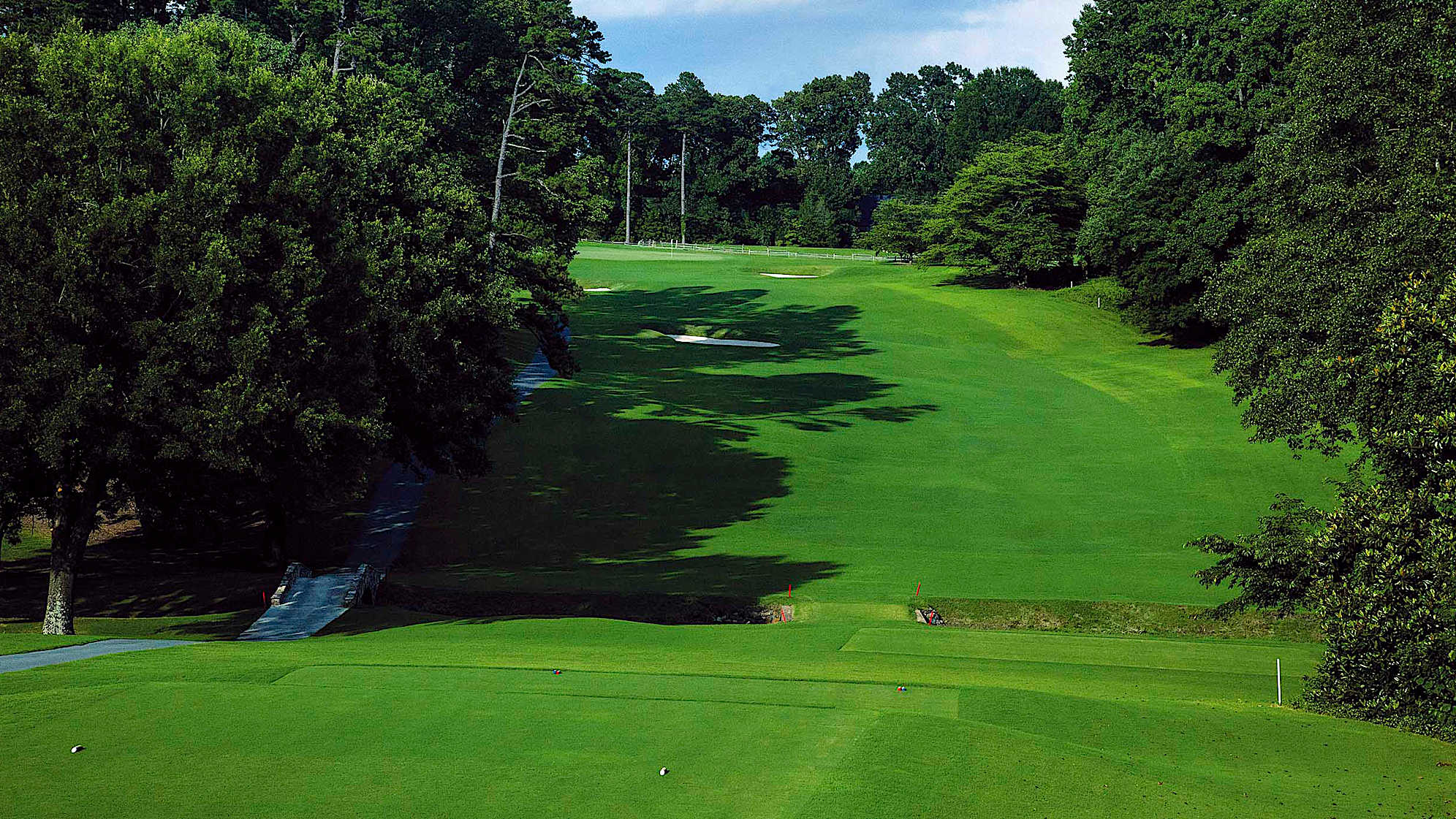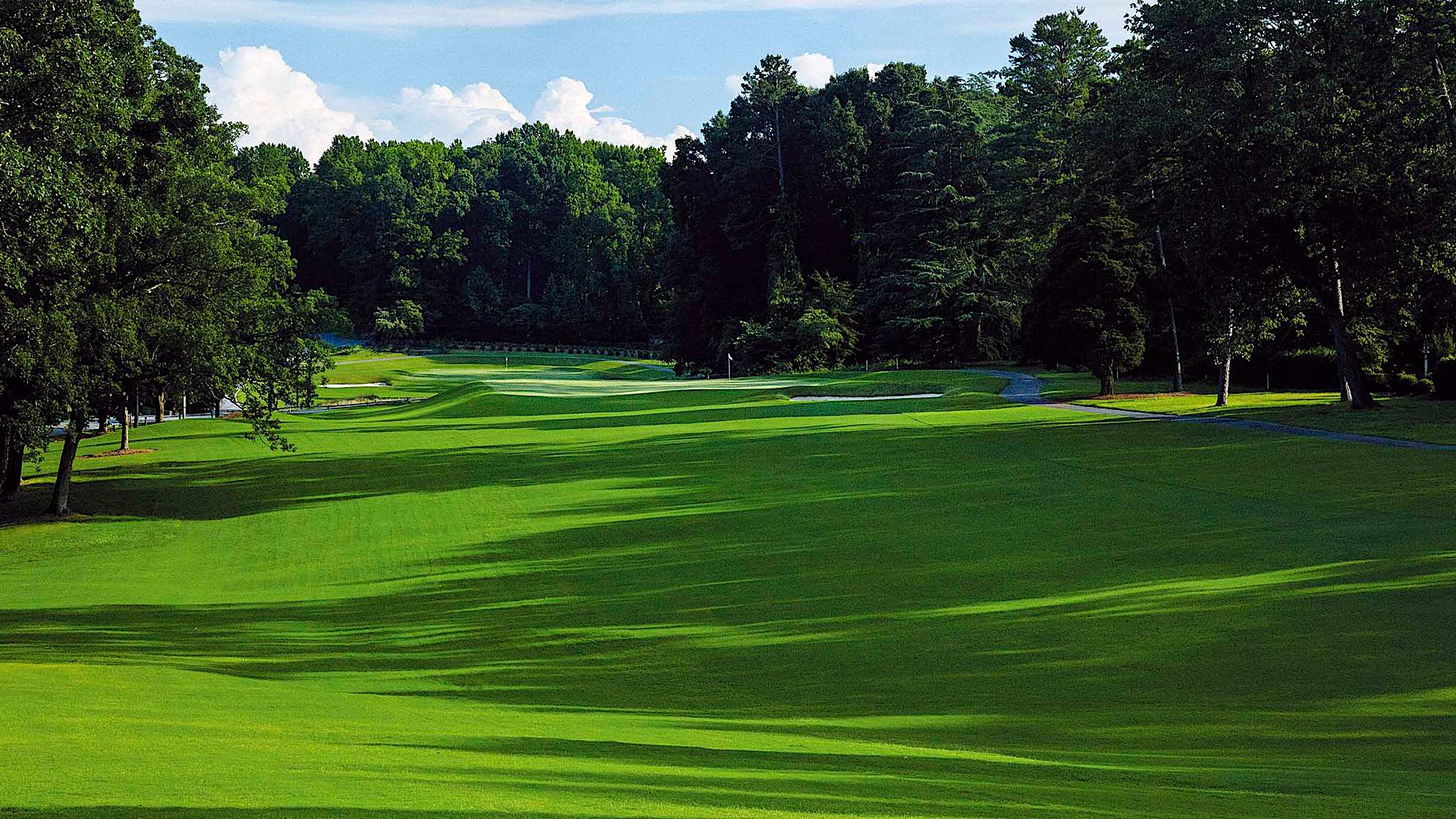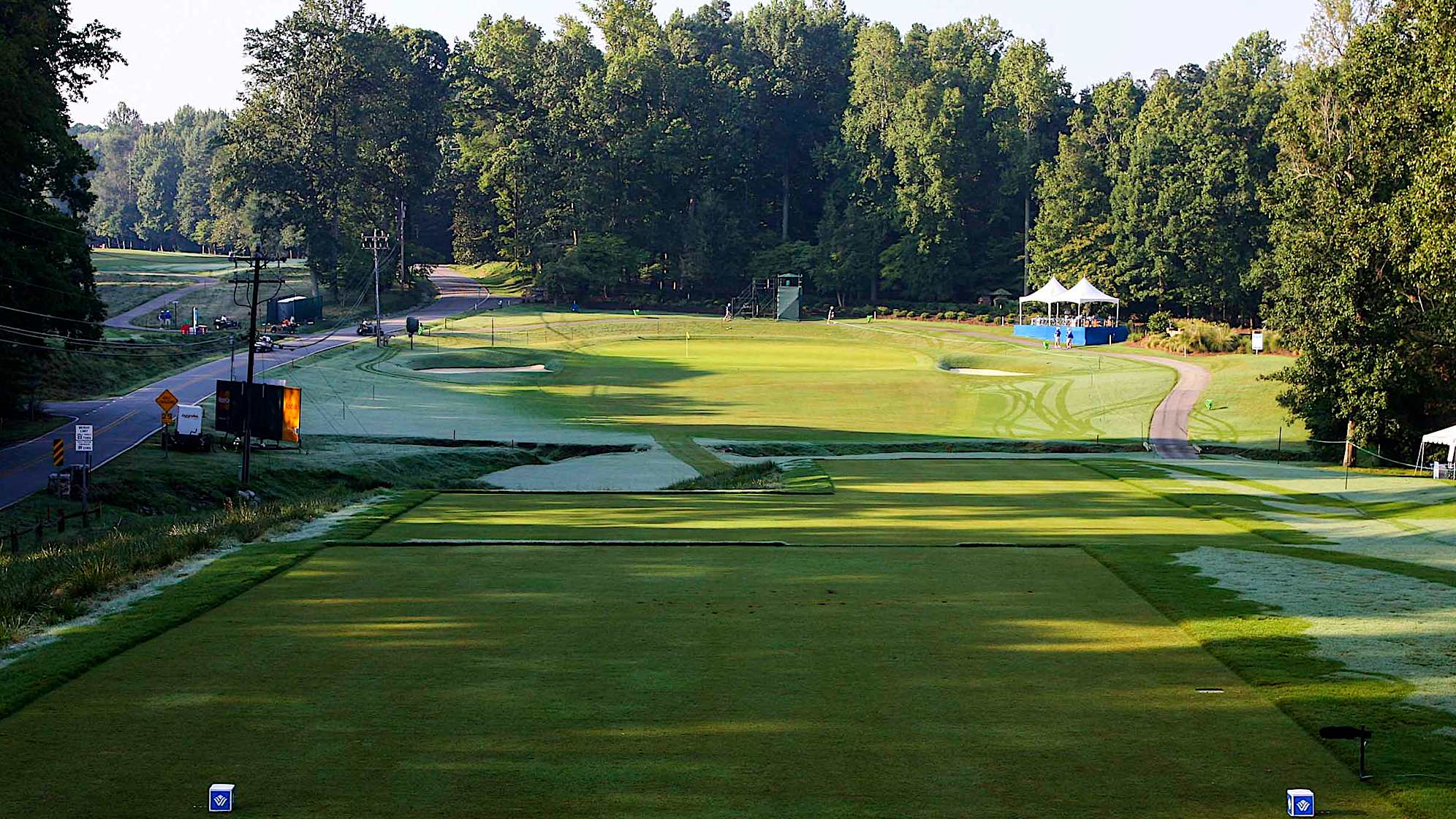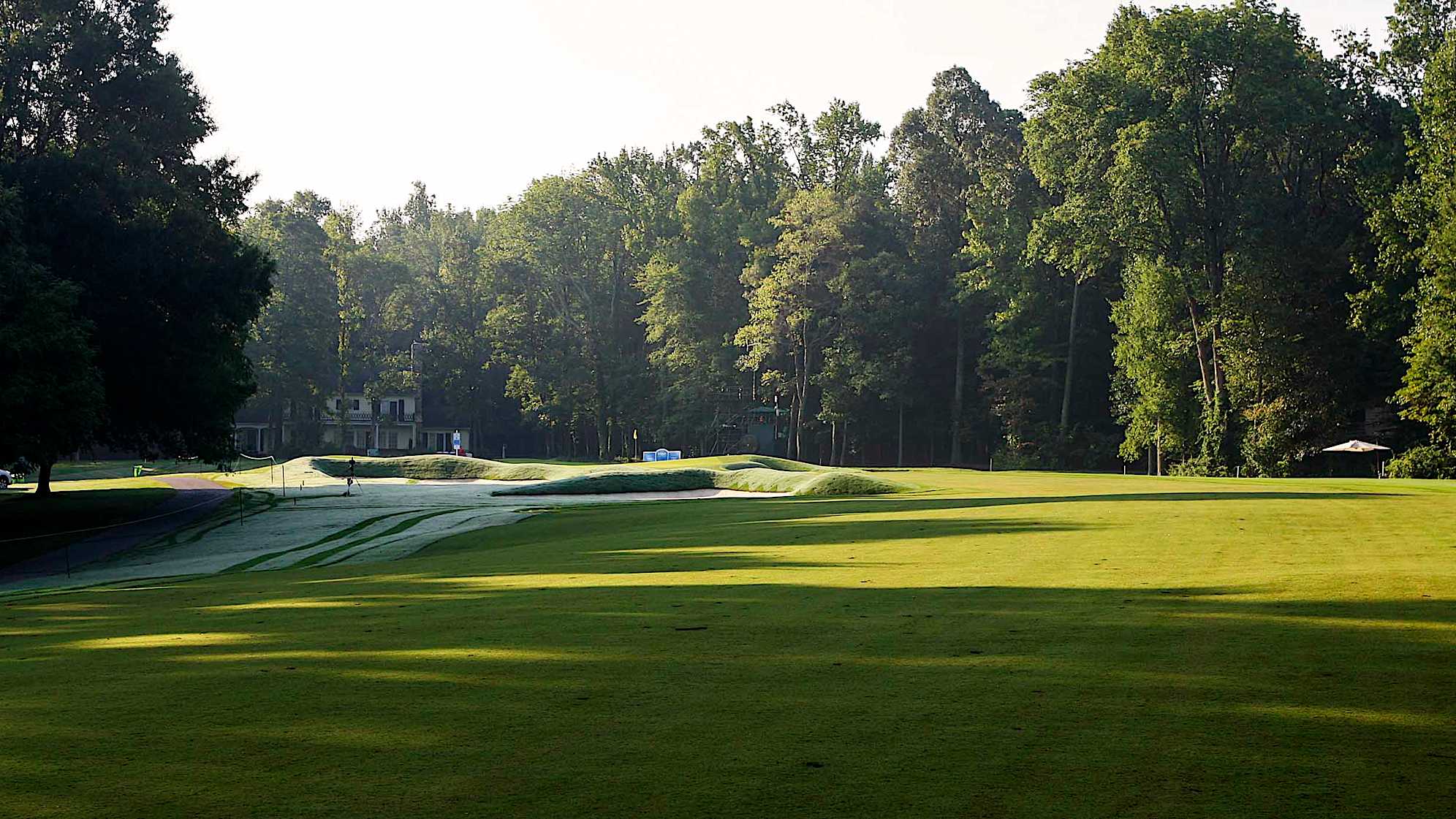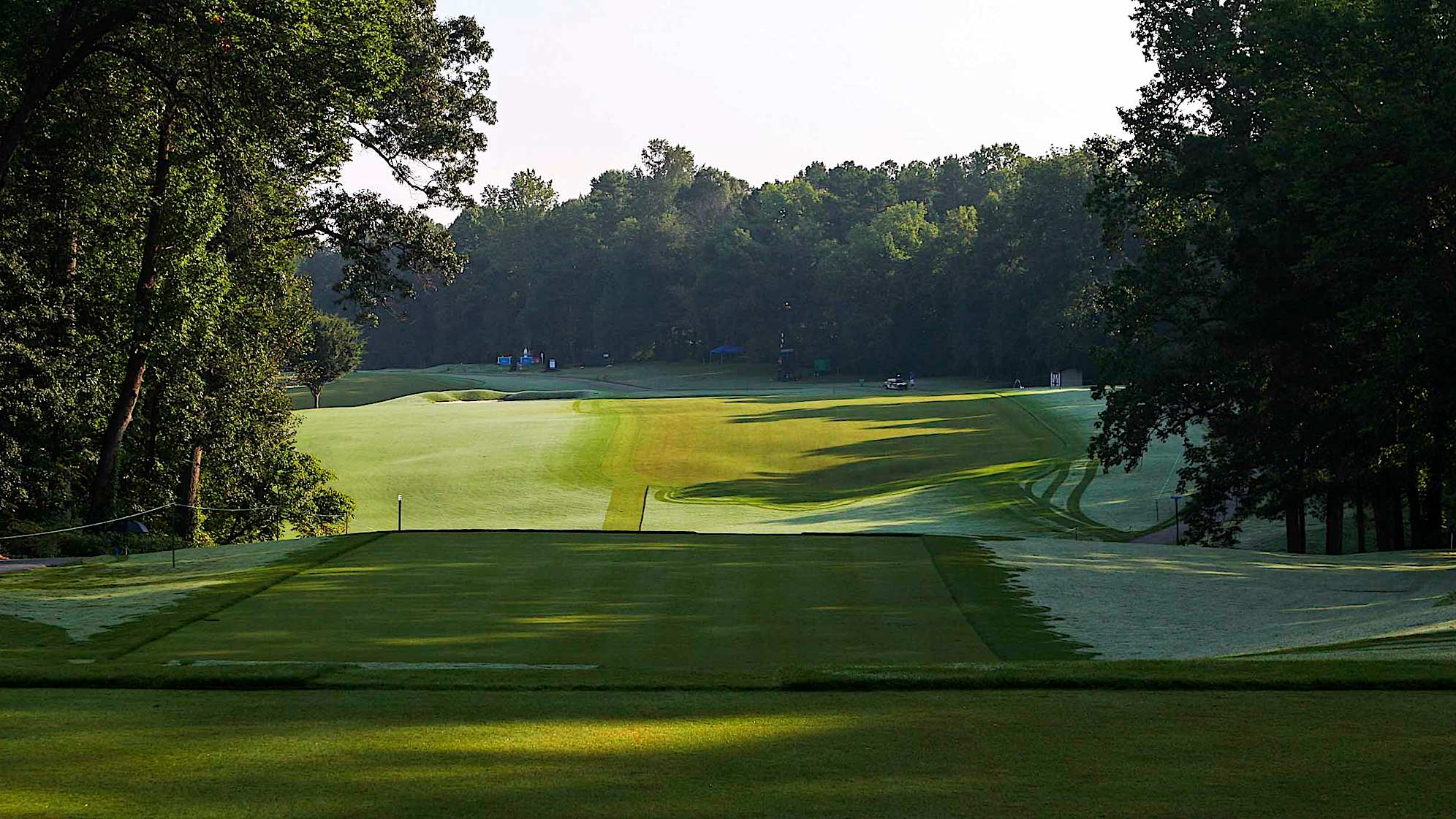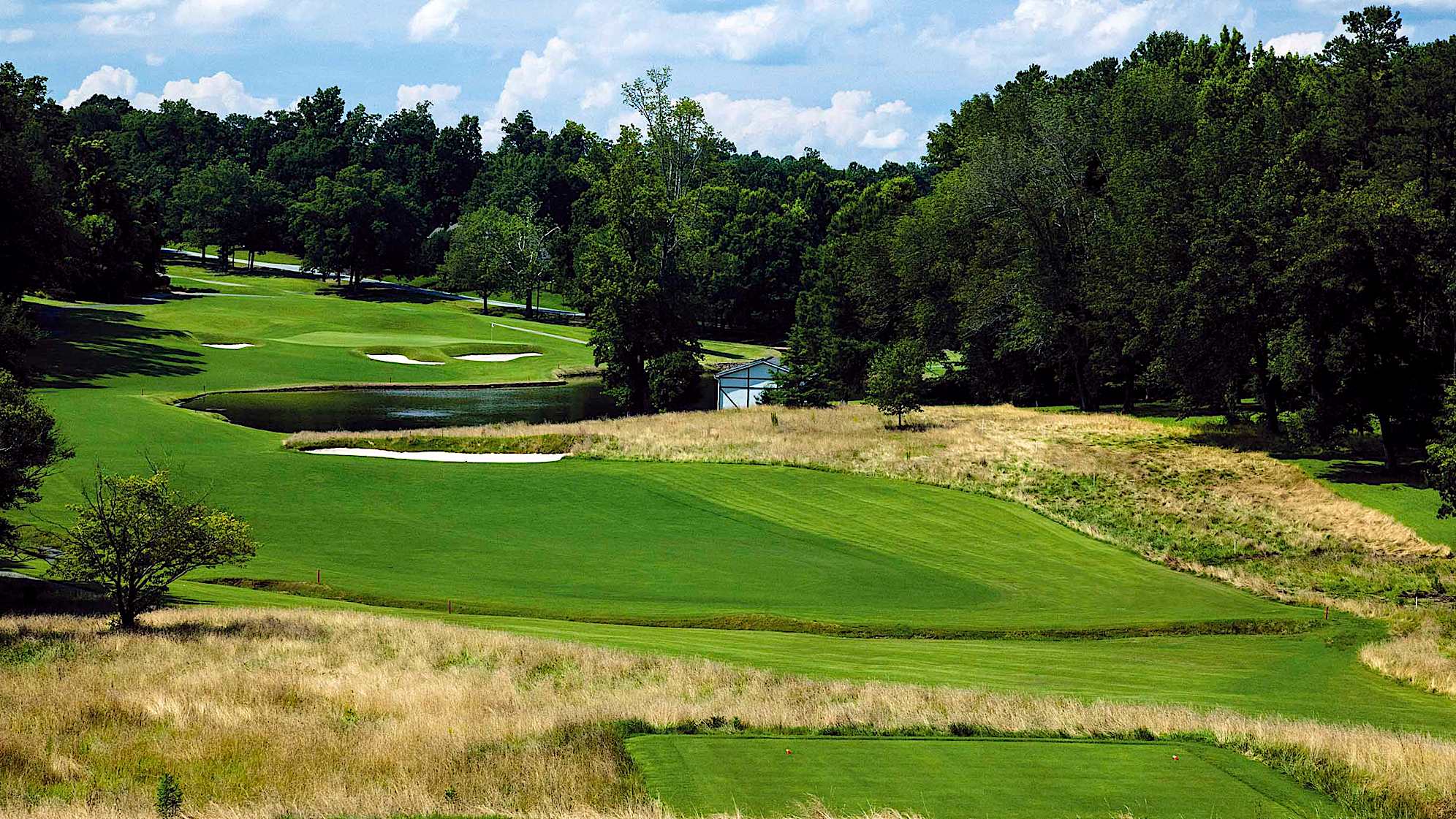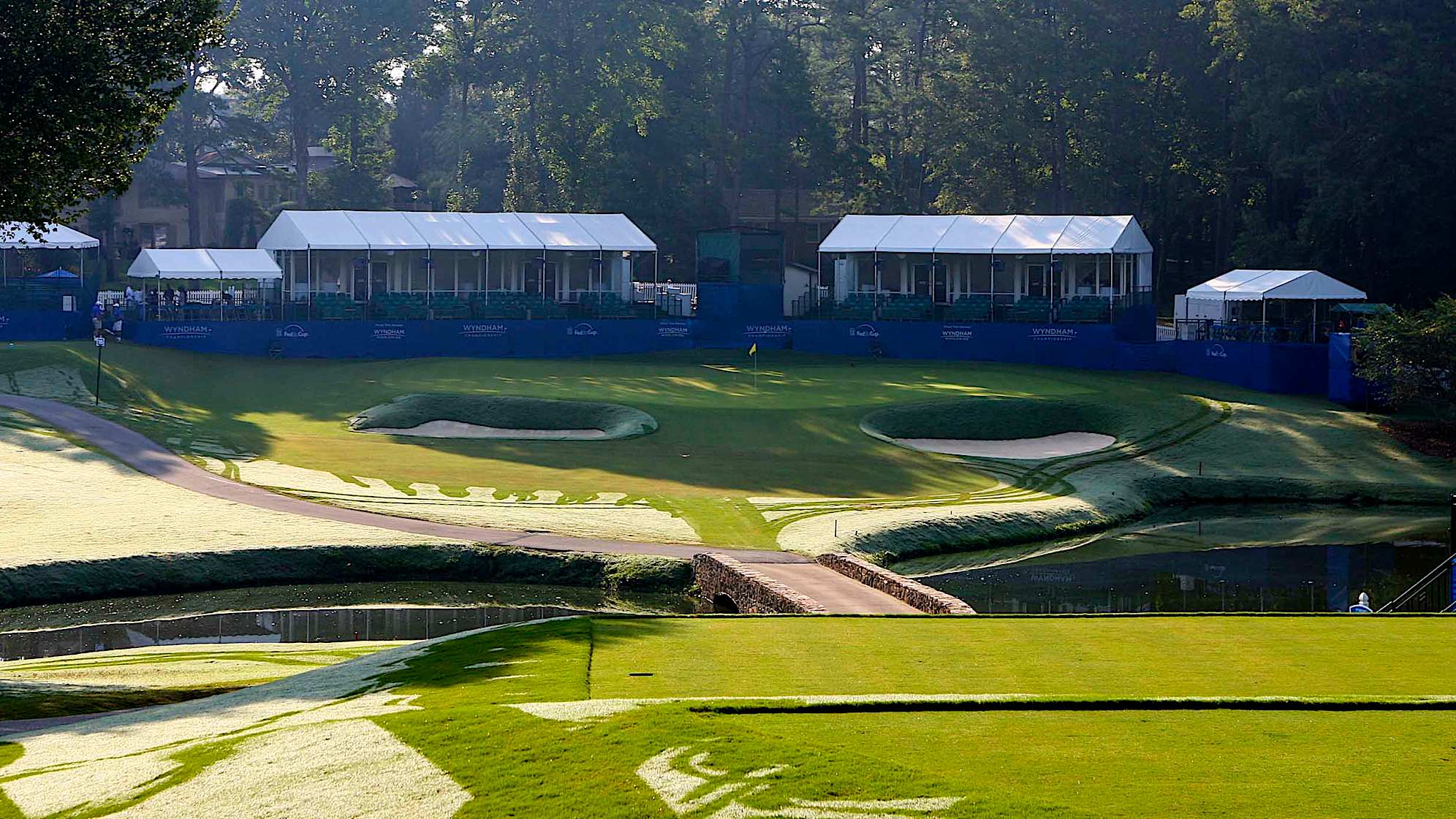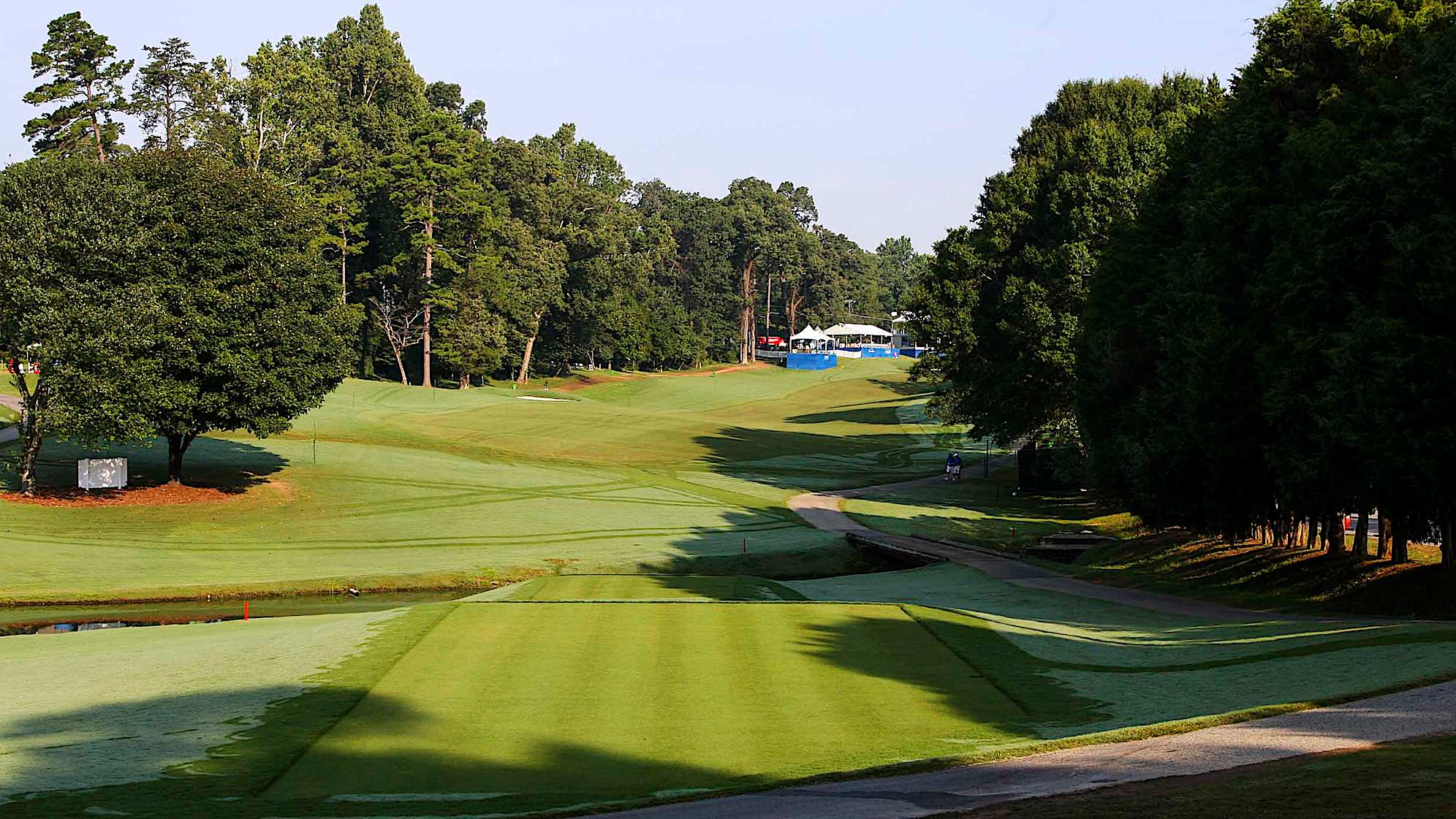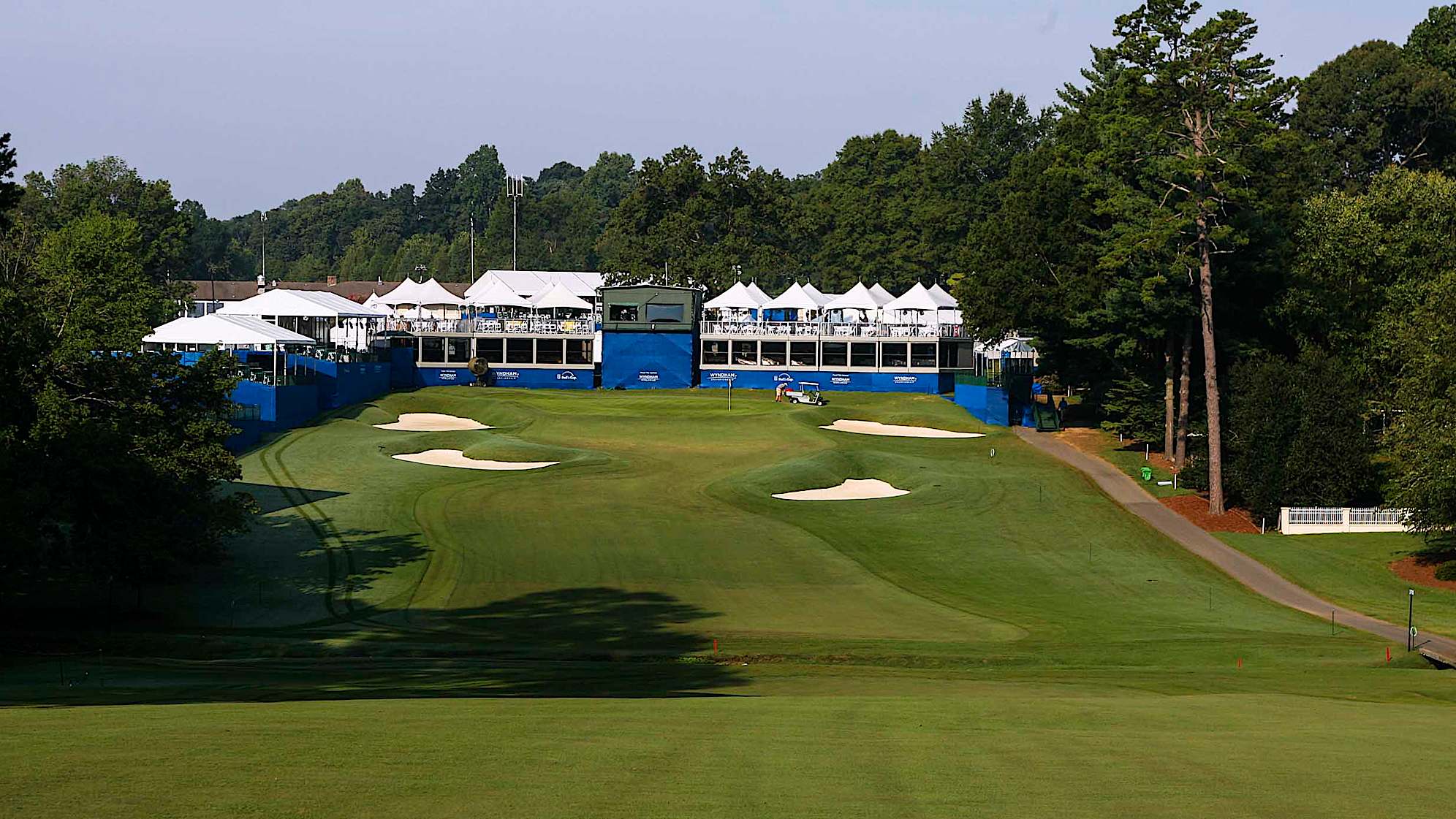Five things to know: Sedgefield Country Club
9 Min Read
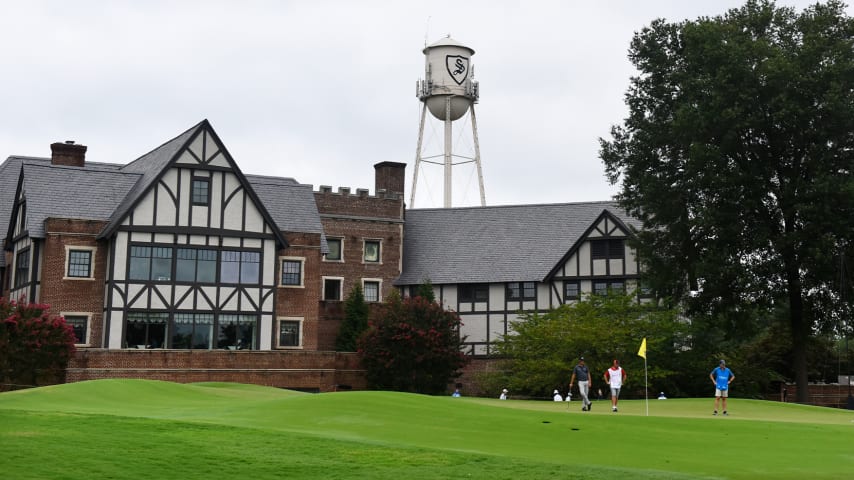
Written by Bradley S. Klein
The Wyndham Championship at Sedgefield Country Club in Greensboro, North Carolina, embodies an ideal mix of tradition and innovation.
The event dates to 1938 and is one of the PGA TOUR’s foundational events. It debuted 85 years ago as the Greater Greensboro Open and was played under that moniker for its first 50 years. Only TOUR stops in Los Angeles and Phoenix are older. With the advent of the FedExCup in 2007, the Wyndham Championship also became the last FedExCup Regular Season event at which players could qualify for the end-of-season FedExCup Playoffs. The qualifying is tougher than ever, as only the top 70 will advance to the FedEx St. Jude Championship (before 2023, the top 125 qualified for the Playoffs).
1. Roll call of major winners
Events are made great by the players who have won there, and few events can match the Wyndham’s lineage of legendary victors. Sam Snead won the first of his eight Greater Greensboro titles at the inaugural event in 1938 when he was 26 years old; his last win in Greensboro came in 1965, when he was 53 years old. That win also marked the last of his record 82 PGA TOUR career wins.
In 1978, Seve Ballesteros – all of 20 years, 11 months old – made Greensboro his American professional debut and promptly won the event for the first of his nine PGA TOUR triumphs.
There’s an impressive list of Greensboro winners whose careers include one of the professional majors: Ralph Guldahl (1939), Ben Hogan (1940), Byron Nelson (1941, 1945), Lloyd Mangrum (1948), Doug Ford (1954), Bob Goalby (1958), Dow Finsterwald (1959), Billy Casper (1962, 1968), Julius Boros (1964), George Archer (1967, 1972), Gene Littler (1969), Gary Player (1970), Bob Charles (1974), Tom Weiskopf (1975), Al Geiberger (1976), Raymond Floyd (1979), Craig Stadler (1980), Larry Nelson (1981), Lanny Wadkins (1983), Sandy Lyle (1986, 1988), Scott Simpson (1987), Steve Elkington (1990), Mark Brooks (1991), Davis Love III (1992, 2006, 2015), Mark O’Meara (1996), Hal Sutton (2000), Webb Simpson (2011), Sergio Garcia (2012), Patrick Reed (2013) and Henrik Stenson (2017).
2. Classic Donald Ross design
Sedgefield is the handiwork of Hall of Fame architect Donald Ross (1872-1948). It came at a time – 1926 – when Ross was at his creative apogee. That’s remarkable, given how busy the transplanted Scotsman was at the time, juggling 20 different projects, 17 of them new course designs, including such other outstanding layouts as Country Club of Birmingham (36 holes) in Alabama, Athens Country Club in Georgia, Franklin Hills Country Club in Michigan, Country Club of Buffalo in New York, and in North Carolina, Cape Fear Country Club, Roaring Gap Club and Wilmington Municipal Golf Course.
It helped Ross in his management of Sedgefield that his main design office was only 75 miles to the south, at the Pinehurst Resort, where he spent every winter. From there he would regularly ride the rails or go out touring in his car to visit sites throughout the Southeast and beyond.
Part of Ross’ genius was his ability to route golf courses – finding a natural sequence of holes such that they fit the land and provided a seamless transition. At Sedgefield, the golf course was part of an upscale real estate development. The homes remain set back very generously and thus out of play. Ross’s routing is disarmingly simple here – two adjoining, counterclockwise loops of nine holes each that converge upon an elegant, Tudor-style clubhouse.
Over the years, as was the case with many Ross courses, the greens shrank, the tree-lined playing corridors overgrew intended playing lines, and some clumsy renovation work betrayed the original design intent.
In 2007, the club undertook a 10-month-long total reconstruction of the golf course. The project was led by Ross restoration specialist Kris Spence, a former superintendent whose job posts included a multiyear stint in the late 1980s at nearby Forest Oaks Country Club – which hosted the Wyndham Championship from 1977-2007.
Ever the researcher, Spence unearthed Ross’ own hand-held notes on Sedgefield. It allowed him and his design team to identify original green surfaces, slopes and angles of play that had been lost over the years. The result of restoration – which included extensive drainage, new irrigation, and a complete overhaul of the bunkers, greens and tees – was that in 2008, Sedgefield reclaimed its status as home to the Wyndham.
3. Those greens
Ross is legendary for the quality and interest of his putting surfaces. It’s an art he started crafting as an apprentice under Old Tom Morris at St. Andrews and brought with him to the New World in 1899. While common opinion might mistake the domed greens at Pinehurst No. 2 as representative of Ross, in fact those convex surfaces are anomalous. Far more characteristic of Ross’ handiwork are the subtle, slightly elevated fill pads that Sedgefield sports – where the surface rises ever-so slightly out of the native topography, with bunkers sunk at the base of the pedestal forming those greens and the various rolls, falloffs and shelves presented clearly to the approaching golfer.
At an average size of 6,000 square feet, the greens at Sedgefield are an ideal size to test approach accuracy while providing meaningful difference day-to-day in hole location. They also produce diverse recovery shots for marginally wayward approaches since the greens tend to fall off slightly on the perimeters – sometimes into shortgrass roll-offs, sometimes into bunkers or dense rough.
The 2007 Spence restoration had originally planted the surfaces in Bentgrass. But in a nod to the Wyndham Championship – and the need to produce ideal conditions in August heat – the decision was made in 2010 to re-turf to Champion Bermudagrass.
How’s this for a nervy renovation? The regrassing to bermudagrass in 2010 took place only 10 weeks before that year’s Wyndham Championship. Such is the reliability of that turf type’s growth in warm weather that the greens were sprigged – not sodded – in late May, and six weeks later they were all but fully established.
Ever since, the players have extolled the greens as among the finest bermudagrass surfaces they play all year. That’s the combined result of Ross’ original design intent, Spence’s restoration and the ability of course superintendent Chad Cromer and his team to keep things presented in peak shape.
4. Recent memorable moments
In 2010, Arjun Atwal became the first Monday qualifier to win a PGA TOUR event since Fred Wadsworth took the 1986 Southern Open. It did not come easily for the India native, the first from his country to play on TOUR.
A course-record 61 in the first round created a two-shot cushion, but by the time he stood on the 16th tee Sunday he was in a seven-way tie for the lead. A birdie on the short par 3 and a par at the 17th left him needing a par to win. After driving into the rough, Atwal took a 3-wood and deliberately played long for the stands behind the green. From there, he got a greenside drop, chipped up to 6 feet and calmly sank the par putt to become the first – and still only – person from his country to win on TOUR.
In 2013, TOUR rookie Jordan Spieth dueled Patrick Reed to overtime. On the first playoff hole, the long par-4 18th, Reed was sitting comfortably 10 feet from the hole in two, while Spieth had had to chip out of the woods to safety before hitting his third shot 35 feet away. In a clear case of rescuing himself from disaster, Spieth sank the putt for par while Reed missed his birdie to win.
The roles flipped on the second playoff hole, the par-4 10th, where Spieth played two quality shots to within birdie range, while Reed was forced to play his second from a brutal lie and stance well right in the woods, under trees and on a pine-straw-covered upslope close to OB.
Reed hit a low rising cut 7-iron, a shot he described afterward as “the best shot of my life,” to within 7 feet and sank the putt for a winning birdie after Spieth had missed his try and settled for par. Guests at the club who’ve viewed the online video of Reed’s miraculous shot still try today to duplicate it – usually to no avail.
5. Three holes
Sedgefield is not a big ballpark. At par 70 and measuring 7,030 yards, it is not the kind of course that favors big hitters. With only 25 acres of fairway out there and thick bermudagrass rough lining both sides, the emphasis is upon hitting fairways and playing approach shots from the short grass. Three of the four closing holes confirm this.
No. 15: par 5, 549 yards
This is basically a par 4.5, easily within reach in two for everyone in the field. The hole plays 30 feet downhill from tee to green and calls for a very carefully controlled second shot. The trick is not reaching the green – but holding it once the ball carries the phalanx of front bunkers.

Overview of No. 15 at Sedgefield Country Club
No. 16: par 3, 175 yards
Ross invariably built one short par 3 on his courses, most of them with front bunkers, a thumbprint and a lot of trouble behind. This one fits the bill. Control is the watchword, especially on a hole like this that plays downhill 10 feet from tee to green and makes it imperative that a ball stop soon upon landing. This is where amateurs have trouble and pros have a field day. It’s also the kind of hole where you can only get in trouble by getting too greedy; front center of the green is not a bad place to be four days in a row.
The mantra of playing Sedgefield’s greens, as suggested by the club’s PGA professional Eric Ferguson, is a healthy reminder here and everywhere: “You want to stay below the hole, and you never want to short-side yourself,” he said.

PGA professional tips on playing No. 16 at Sedgefield Country Club
No. 18: par 4, 507 yards
Normally a par 5 for the members, this finishing hole is a demanding two-shotter for TOUR players. The hole tumbles downhill 50 feet from tee to landing area, then ascends halfway back up to a green bunkered steeply up front and tipped noticeably forward. Given the long run out of tee shots, players are hitting short irons to the green; the effort to elevate the ball and carry a pair of front flanking bunkers often leaves players with a tricky downhill putt. There will be a of nervous players standing over 4-, 5- and 6-foot putts that, given the calculus of the FedExCup top-70 tables, will prove very consequential on Sunday – and perhaps more consequential on Friday.
Sedgefield Country Club - Greensboro, N.C.
Card of the Course
| Hole | Par | Yardage |
| 1 | 4 | 418 |
| 2 | 4 | 442 |
| 3 | 3 | 174 |
| 4 | 4 | 428 |
| 5 | 5 | 529 |
| 6 | 4 | 423 |
| 7 | 3 | 223 |
| 8 | 4 | 374 |
| 9 | 4 | 416 |
| Nine-hole total | 35 | 3,427 |
| 10 | 4 | 440 |
| 11 | 4 | 486 |
| 12 | 3 | 235 |
| 13 | 4 | 405 |
| 14 | 4 | 505 |
| 15 | 5 | 545 |
| 16 | 3 | 175 |
| 17 | 4 | 406 |
| 18 | 4 | 507 |
| Nine-hole total | 35 | 3,603 |
| Course total | 70 | 7,030 |

